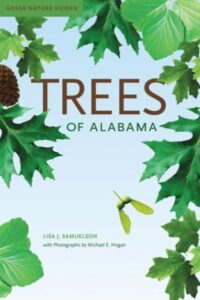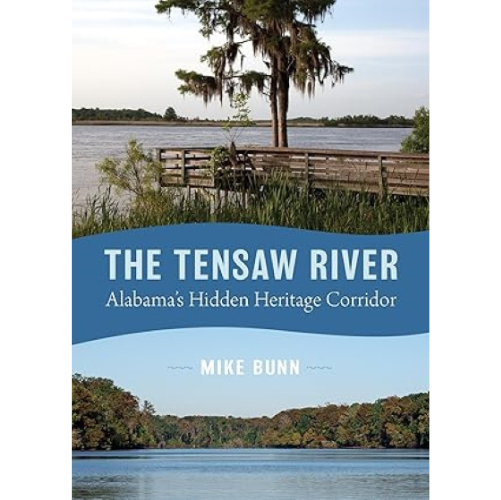By Lisa J. Samuelson
The University of Alabama Press, 2020
Paperback: $34.95; eBook: $34.95
Genre: Nonfiction, Educational
Reviewed by Jim Plott
 Auburn University forestry professor Lisa Samuelson might have unintentionally stirred up a controversy with her latest book, Trees of Alabama. Should you use it as a field guide to help identify trees in the woods, or do you keep it at home as a library reference book? Certainly, the cover and pages are thick enough to withstand the outdoors even in challenging conditions. Yet placing it on a bookshelf or an accent for a coffee table ensures its availability during indoor research.
Auburn University forestry professor Lisa Samuelson might have unintentionally stirred up a controversy with her latest book, Trees of Alabama. Should you use it as a field guide to help identify trees in the woods, or do you keep it at home as a library reference book? Certainly, the cover and pages are thick enough to withstand the outdoors even in challenging conditions. Yet placing it on a bookshelf or an accent for a coffee table ensures its availability during indoor research.
What is not open for debate is that Samuelson has developed a comprehensive, user-friendly, and long-overdue manual useful in the hands of anyone from nature enthusiasts to seasoned foresters and biologists. Trees of Alabama is part of the Gosse Nature Guides, a series of books on plants and animals in Alabama. Philip Henry Gosse was an English naturalist who spent time in Alabama in the 1830s recording the plant life and wildlife in writings, sketches, and paintings. Here, Samuelson describes more than 140 trees. While I, a novice, might be more apt to label some entries as bushes or shrubs than trees, I am more than delighted that they were included. Each tree listing, accompanied by excellent photographs from photographer Michael E. Hogan, depicts a species’ most recognizable characteristics – leaf shape, berry, flower, bark, etc., making identification easier.
Samuelson begins Trees of Alabama with a guide to identifying trees, starting with the basics, like leaf shapes and arrangements, and then delving into the essential characteristics of tree families. She devotes a page or two to each tree and packs each entry with useful information: description, plant family, habitat, companion plants and trees, and general uses. And while Latin names are a must, Samuelson doesn’t just stop there; she provides the meaning of the Latin name to ensure clarity. For instance, the Latin name for the sourwood tree is Oxydendrum arboretum, which basically means sour tree. Common names for trees are included as well, even though many trees in Alabama are often referred to by different names in different regions of the state.
locate any particular tree. However, Samuel notes that the maps are only general guides and are based on observation or written documents. Still, the maps create added interest. For instance, cedar trees can be found in each of Alabama’s 67 counties, while Macon County is the only county where a search for a sparkleberry tree might prove difficult.
Also of particular interest is that the American chestnut can be found in about 15 counties in Alabama. An interesting point is that the American chestnut, once common throughout much of the Southeast, was basically wiped out by a blight in 1900. Samuelson aptly notes that most of today’s pure chestnut trees live only to infancy before the blight, which survives on oak trees, forces chestnuts to die back. Hybrids of the Chinese chestnut, resistant to the blight, and the American chestnut are being tested.
During my years as a student at Auburn, all my roommates and friends happened to be forestry majors; my interest in trees and wildflowers didn’t come until years later. Now, while I may not have a degree in forestry, thanks to Samuelson’s book, I believe I have the next best thing.
Jim Plott, who works in public relations with the state of Alabama, spent nearly 30 years as an Alabama journalist, including stops at The Montgomery Advertiser, The Prattville Progress, and The Monroe Journal. He is a graduate of Auburn University with a Bachelor of Arts in journalism. He grew up in Montgomery and now lives in Prattville but considers all of Alabama his hometown.






Leave A Comment
You must be logged in to post a comment.